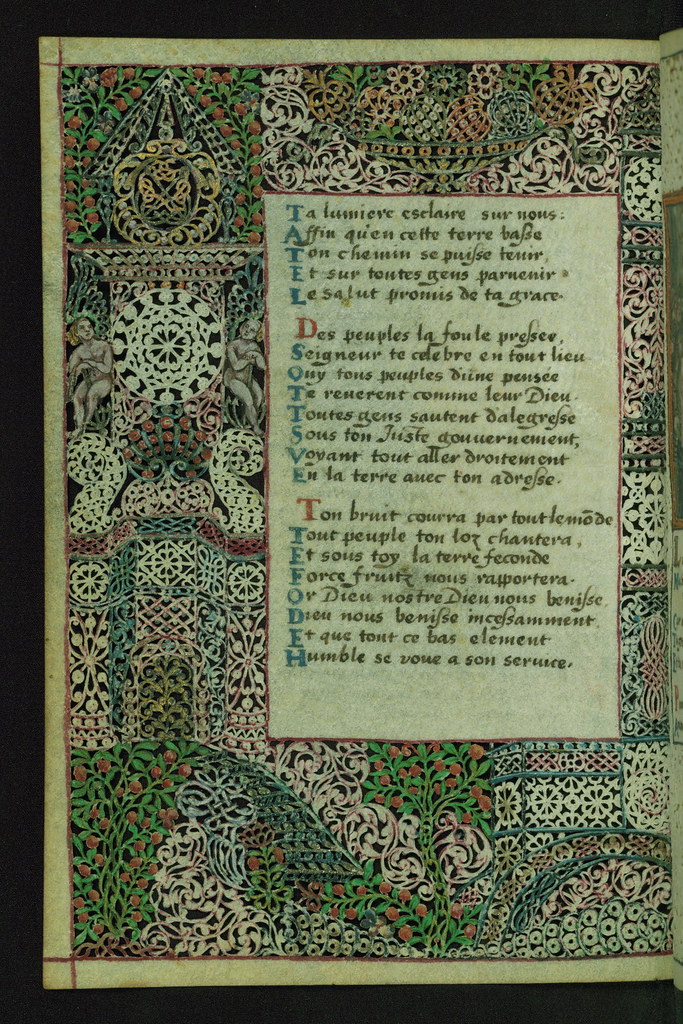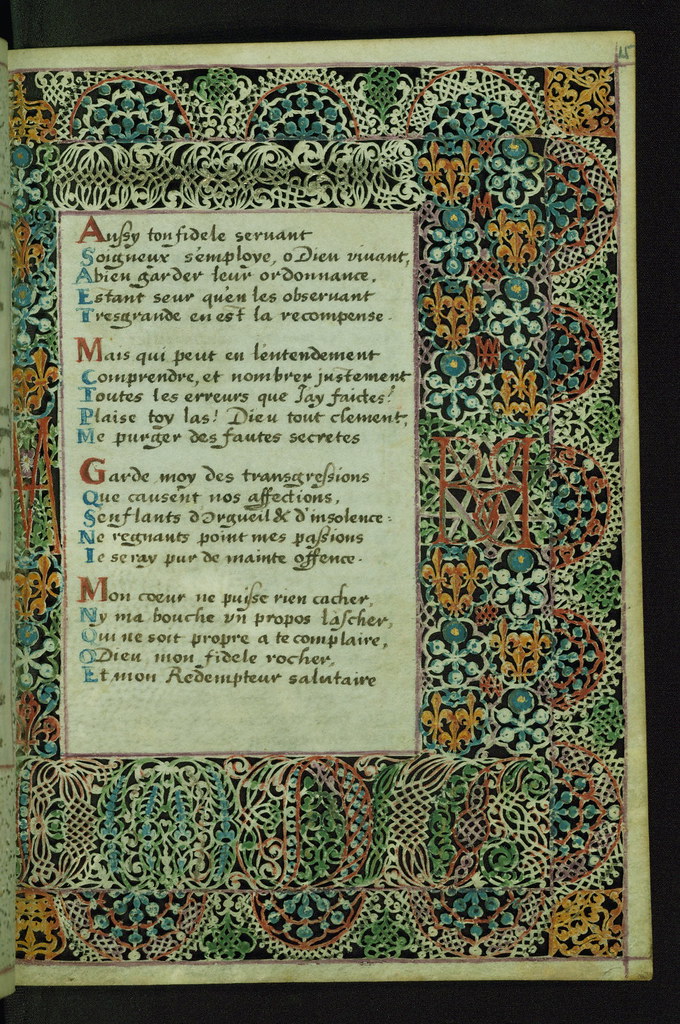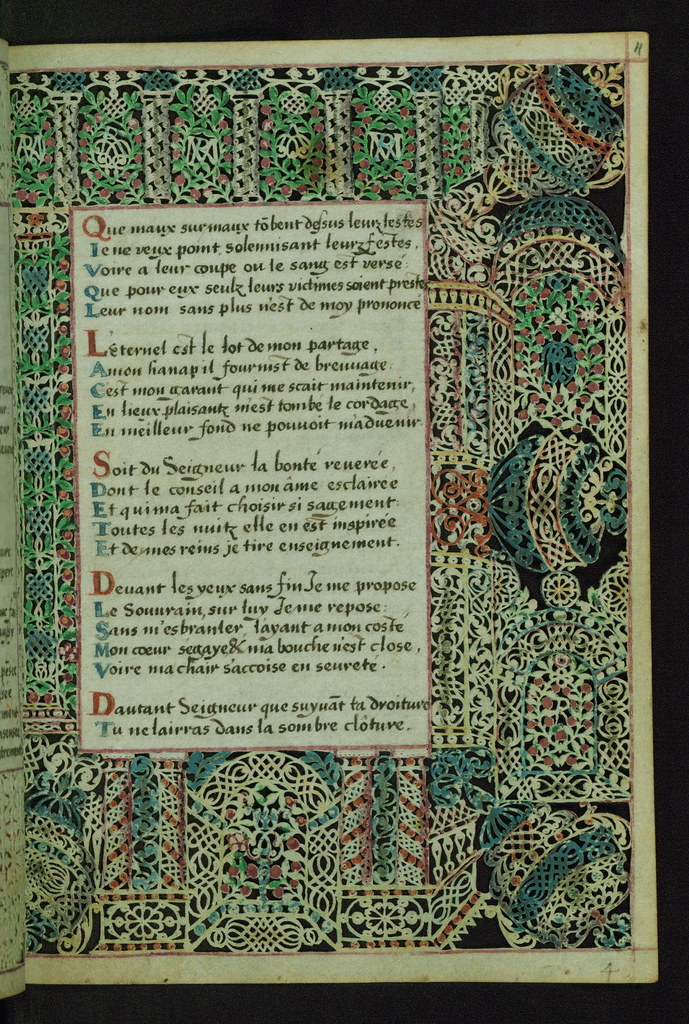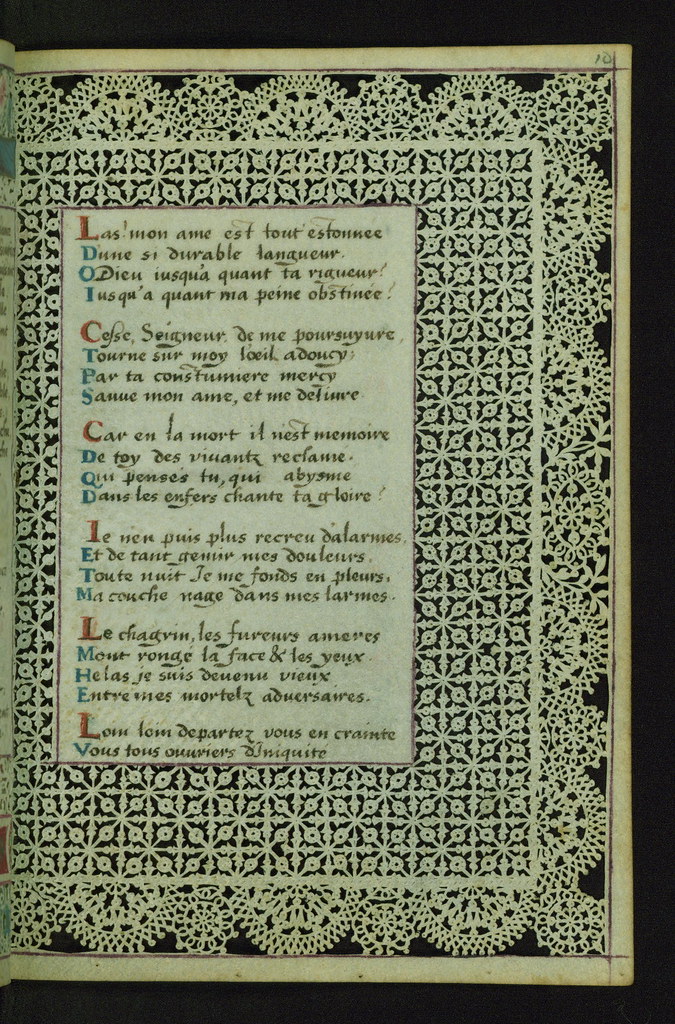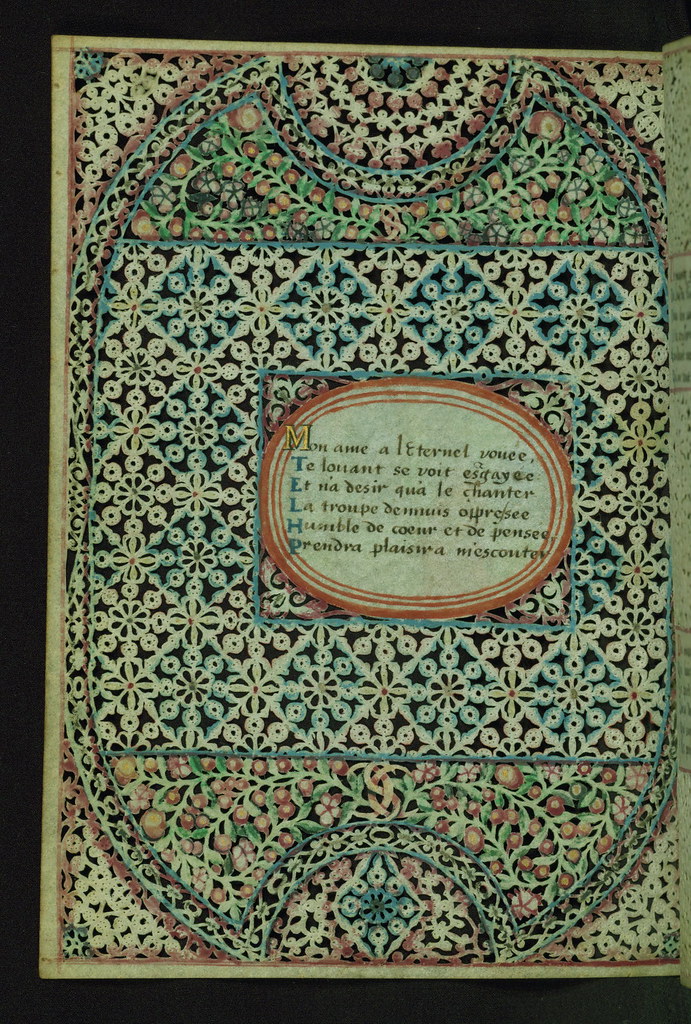#notable binding
Lace Book of Marie de’ Medici, Lace margins, Walters Manuscript W.494, Folio 17v by Walters Art Museum
Via Flickr:
This Prayerbook was made for Marie de’ Medici in the second quarter of the seventeenth century. Beyond its provenance as a personal book owned by the famous queen, it is exceptional for its intricately cut borders, which transform the parchment margins into lace. This effect was created using a technique known as “canivet,” in which a small knife was used to cut ornate patterns into paper or parchment. An art form that flourished originally among nuns in France, Germany, and the Netherlands beginning in the sixteenth century, it was employed to exceptional effect in several manuscripts connected with Marie de’ Medici. The Walters manuscript, made for her while she was regent of France, and wife of King Henry IV, contains twenty-eight miniatures, including original religious imagery as well as several later additions: a gouache portrait of the elderly queen, and nine small miniatures produced in Bruges ca. 1450 by an artist influenced by the Eyckian and Gold Scrolls styles prevalent at the time; the coat-of-arms of Marie de Medici, as well as her monogram. The Walters manuscript retains its original binding composed of mosaic inlays in green and black leather, as well as fine gilt pointillé foliate tooling, and a replica of the binding was created by Léon Gruel for Henry Walters on one of his seventeenth-century printed books (92.467) that also connects to Marie de’ Medici. All manuscript images and descriptions were created and are provided through Preservation and Access grants awarded to the Walters Art Museum by the National Endowment for the Humanities, 2008-2014. Access a complete set of high-resolution archival images of this manuscript for free on the Digital Walters at www.thedigitalwalters.org/Data/WaltersManuscripts/html/W494/
Lace Book of Marie de’ Medici, Lace margins, Walters Manuscript W.494, Folio 15r by Walters Art Museum
Via Flickr:
This Prayerbook was made for Marie de’ Medici in the second quarter of the seventeenth century. Beyond its provenance as a personal book owned by the famous queen, it is exceptional for its intricately cut borders, which transform the parchment margins into lace. This effect was created using a technique known as “canivet,” in which a small knife was used to cut ornate patterns into paper or parchment. An art form that flourished originally among nuns in France, Germany, and the Netherlands beginning in the sixteenth century, it was employed to exceptional effect in several manuscripts connected with Marie de’ Medici. The Walters manuscript, made for her while she was regent of France, and wife of King Henry IV, contains twenty-eight miniatures, including original religious imagery as well as several later additions: a gouache portrait of the elderly queen, and nine small miniatures produced in Bruges ca. 1450 by an artist influenced by the Eyckian and Gold Scrolls styles prevalent at the time; the coat-of-arms of Marie de Medici, as well as her monogram. The Walters manuscript retains its original binding composed of mosaic inlays in green and black leather, as well as fine gilt pointillé foliate tooling, and a replica of the binding was created by Léon Gruel for Henry Walters on one of his seventeenth-century printed books (92.467) that also connects to Marie de’ Medici. All manuscript images and descriptions were created and are provided through Preservation and Access grants awarded to the Walters Art Museum by the National Endowment for the Humanities, 2008-2014. Access a complete set of high-resolution archival images of this manuscript for free on the Digital Walters at www.thedigitalwalters.org/Data/WaltersManuscripts/html/W494/
Lace Book of Marie de’ Medici, Transfiguration, Walters Manuscript W.494, fol. 13r by Walters Art Museum
Via Flickr:
This Prayerbook was made for Marie de’ Medici in the second quarter of the seventeenth century. Beyond its provenance as a personal book owned by the famous queen, it is exceptional for its intricately cut borders, which transform the parchment margins into lace. This effect was created using a technique known as “canivet,” in which a small knife was used to cut ornate patterns into paper or parchment. An art form that flourished originally among nuns in France, Germany, and the Netherlands beginning in the sixteenth century, it was employed to exceptional effect in several manuscripts connected with Marie de’ Medici. The Walters manuscript, made for her while she was regent of France, and wife of King Henry IV, contains twenty-eight miniatures, including original religious imagery as well as several later additions: a gouache portrait of the elderly queen, and nine small miniatures produced in Bruges ca. 1450 by an artist influenced by the Eyckian and Gold Scrolls styles prevalent at the time; the coat-of-arms of Marie de Medici, as well as her monogram. The Walters manuscript retains its original binding composed of mosaic inlays in green and black leather, as well as fine gilt pointillé foliate tooling, and a replica of the binding was created by Léon Gruel for Henry Walters on one of his seventeenth-century printed books (92.467) that also connects to Marie de’ Medici. All manuscript images and descriptions were created and are provided through Preservation and Access grants awarded to the Walters Art Museum by the National Endowment for the Humanities, 2008-2014. Access a complete set of high-resolution archival images of this manuscript for free on the Digital Walters at www.thedigitalwalters.org/Data/WaltersManuscripts/html/W494/
Lace Book of Marie de’ Medici, Lace margins, Walters Manuscript W.494, Folio 11r by Walters Art Museum
Via Flickr:
This Prayerbook was made for Marie de’ Medici in the second quarter of the seventeenth century. Beyond its provenance as a personal book owned by the famous queen, it is exceptional for its intricately cut borders, which transform the parchment margins into lace. This effect was created using a technique known as “canivet,” in which a small knife was used to cut ornate patterns into paper or parchment. An art form that flourished originally among nuns in France, Germany, and the Netherlands beginning in the sixteenth century, it was employed to exceptional effect in several manuscripts connected with Marie de’ Medici. The Walters manuscript, made for her while she was regent of France, and wife of King Henry IV, contains twenty-eight miniatures, including original religious imagery as well as several later additions: a gouache portrait of the elderly queen, and nine small miniatures produced in Bruges ca. 1450 by an artist influenced by the Eyckian and Gold Scrolls styles prevalent at the time; the coat-of-arms of Marie de Medici, as well as her monogram. The Walters manuscript retains its original binding composed of mosaic inlays in green and black leather, as well as fine gilt pointillé foliate tooling, and a replica of the binding was created by Léon Gruel for Henry Walters on one of his seventeenth-century printed books (92.467) that also connects to Marie de’ Medici. All manuscript images and descriptions were created and are provided through Preservation and Access grants awarded to the Walters Art Museum by the National Endowment for the Humanities, 2008-2014. Access a complete set of high-resolution archival images of this manuscript for free on the Digital Walters at www.thedigitalwalters.org/Data/WaltersManuscripts/html/W494/
Lace Book of Marie de’ Medici, Lace margins, Walters Manuscript W.494, Folio 10r by Walters Art Museum
Via Flickr:
This Prayerbook was made for Marie de’ Medici in the second quarter of the seventeenth century. Beyond its provenance as a personal book owned by the famous queen, it is exceptional for its intricately cut borders, which transform the parchment margins into lace. This effect was created using a technique known as “canivet,” in which a small knife was used to cut ornate patterns into paper or parchment. An art form that flourished originally among nuns in France, Germany, and the Netherlands beginning in the sixteenth century, it was employed to exceptional effect in several manuscripts connected with Marie de’ Medici. The Walters manuscript, made for her while she was regent of France, and wife of King Henry IV, contains twenty-eight miniatures, including original religious imagery as well as several later additions: a gouache portrait of the elderly queen, and nine small miniatures produced in Bruges ca. 1450 by an artist influenced by the Eyckian and Gold Scrolls styles prevalent at the time; the coat-of-arms of Marie de Medici, as well as her monogram. The Walters manuscript retains its original binding composed of mosaic inlays in green and black leather, as well as fine gilt pointillé foliate tooling, and a replica of the binding was created by Léon Gruel for Henry Walters on one of his seventeenth-century printed books (92.467) that also connects to Marie de’ Medici. All manuscript images and descriptions were created and are provided through Preservation and Access grants awarded to the Walters Art Museum by the National Endowment for the Humanities, 2008-2014. Access a complete set of high-resolution archival images of this manuscript for free on the Digital Walters at www.thedigitalwalters.org/Data/WaltersManuscripts/html/W494/
Lace Book of Marie de’ Medici, John the Baptist baptizing Christ, Walters Manuscript W.494, fol. 8r by Walters Art Museum
Via Flickr:
This Prayerbook was made for Marie de’ Medici in the second quarter of the seventeenth century. Beyond its provenance as a personal book owned by the famous queen, it is exceptional for its intricately cut borders, which transform the parchment margins into lace. This effect was created using a technique known as “canivet,” in which a small knife was used to cut ornate patterns into paper or parchment. An art form that flourished originally among nuns in France, Germany, and the Netherlands beginning in the sixteenth century, it was employed to exceptional effect in several manuscripts connected with Marie de’ Medici. The Walters manuscript, made for her while she was regent of France, and wife of King Henry IV, contains twenty-eight miniatures, including original religious imagery as well as several later additions: a gouache portrait of the elderly queen, and nine small miniatures produced in Bruges ca. 1450 by an artist influenced by the Eyckian and Gold Scrolls styles prevalent at the time; the coat-of-arms of Marie de Medici, as well as her monogram. The Walters manuscript retains its original binding composed of mosaic inlays in green and black leather, as well as fine gilt pointillé foliate tooling, and a replica of the binding was created by Léon Gruel for Henry Walters on one of his seventeenth-century printed books (92.467) that also connects to Marie de’ Medici. All manuscript images and descriptions were created and are provided through Preservation and Access grants awarded to the Walters Art Museum by the National Endowment for the Humanities, 2008-2014. Access a complete set of high-resolution archival images of this manuscript for free on the Digital Walters at www.thedigitalwalters.org/Data/WaltersManuscripts/html/W494/
Lace Book of Marie de’ Medici, Lace margins, Walters Manuscript W.494, Folio 6v by Walters Art Museum
Via Flickr:
This Prayerbook was made for Marie de’ Medici in the second quarter of the seventeenth century. Beyond its provenance as a personal book owned by the famous queen, it is exceptional for its intricately cut borders, which transform the parchment margins into lace. This effect was created using a technique known as “canivet,” in which a small knife was used to cut ornate patterns into paper or parchment. An art form that flourished originally among nuns in France, Germany, and the Netherlands beginning in the sixteenth century, it was employed to exceptional effect in several manuscripts connected with Marie de’ Medici. The Walters manuscript, made for her while she was regent of France, and wife of King Henry IV, contains twenty-eight miniatures, including original religious imagery as well as several later additions: a gouache portrait of the elderly queen, and nine small miniatures produced in Bruges ca. 1450 by an artist influenced by the Eyckian and Gold Scrolls styles prevalent at the time; the coat-of-arms of Marie de Medici, as well as her monogram. The Walters manuscript retains its original binding composed of mosaic inlays in green and black leather, as well as fine gilt pointillé foliate tooling, and a replica of the binding was created by Léon Gruel for Henry Walters on one of his seventeenth-century printed books (92.467) that also connects to Marie de’ Medici. All manuscript images and descriptions were created and are provided through Preservation and Access grants awarded to the Walters Art Museum by the National Endowment for the Humanities, 2008-2014. Access a complete set of high-resolution archival images of this manuscript for free on the Digital Walters at www.thedigitalwalters.org/Data/WaltersManuscripts/html/W494/
Lace Book of Marie de’ Medici, Flight into Egypt, Walters Manuscript W.494, fol. 6r by Walters Art Museum
Via Flickr:
This Prayerbook was made for Marie de’ Medici in the second quarter of the seventeenth century. Beyond its provenance as a personal book owned by the famous queen, it is exceptional for its intricately cut borders, which transform the parchment margins into lace. This effect was created using a technique known as “canivet,” in which a small knife was used to cut ornate patterns into paper or parchment. An art form that flourished originally among nuns in France, Germany, and the Netherlands beginning in the sixteenth century, it was employed to exceptional effect in several manuscripts connected with Marie de’ Medici. The Walters manuscript, made for her while she was regent of France, and wife of King Henry IV, contains twenty-eight miniatures, including original religious imagery as well as several later additions: a gouache portrait of the elderly queen, and nine small miniatures produced in Bruges ca. 1450 by an artist influenced by the Eyckian and Gold Scrolls styles prevalent at the time; the coat-of-arms of Marie de Medici, as well as her monogram. The Walters manuscript retains its original binding composed of mosaic inlays in green and black leather, as well as fine gilt pointillé foliate tooling, and a replica of the binding was created by Léon Gruel for Henry Walters on one of his seventeenth-century printed books (92.467) that also connects to Marie de’ Medici. All manuscript images and descriptions were created and are provided through Preservation and Access grants awarded to the Walters Art Museum by the National Endowment for the Humanities, 2008-2014. Access a complete set of high-resolution archival images of this manuscript for free on the Digital Walters at www.thedigitalwalters.org/Data/WaltersManuscripts/html/W494/

